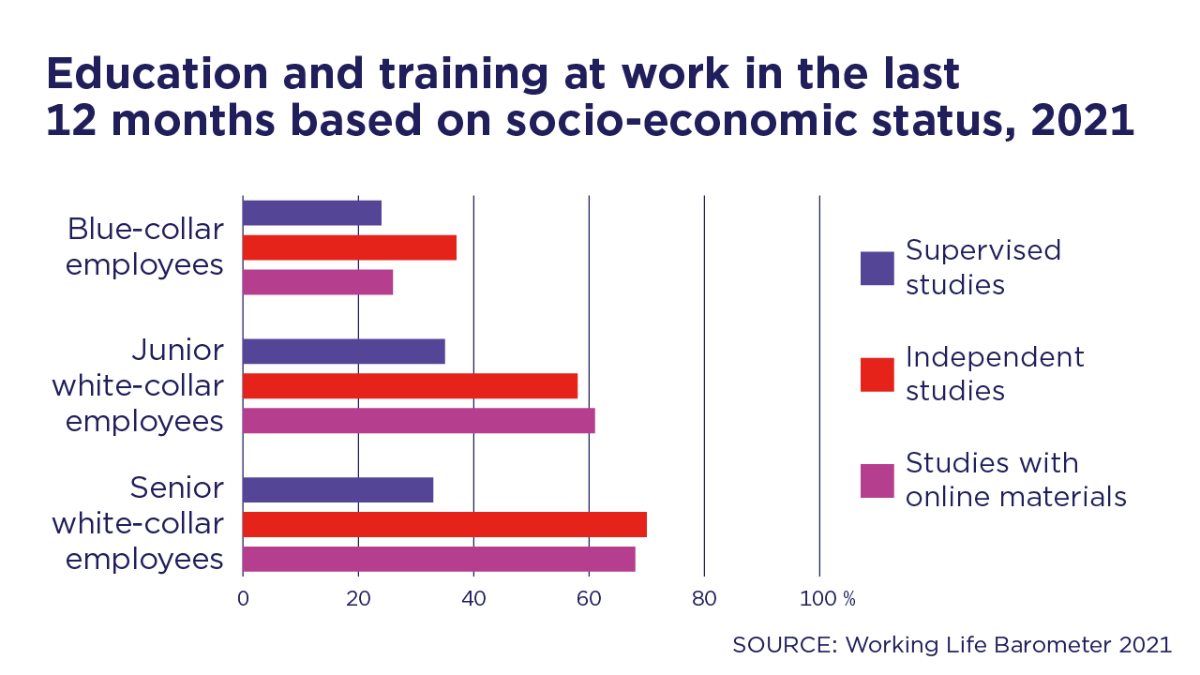Working Life Barometer 2021: Wage and salary earners’ view of the labour market is positive, but continuous learning not available to all

At the end of the second coronavirus year, the views of wage and salary earners on the labour market were fairly positive, according to preliminary data from the Working Life Barometer 2021, which was published on 24 March 2022. More than 80 per cent of them felt that their capacity to work was good in relation to the physical and mental demands of the work.
Most respondents to the Working Life Barometer were confident they would find work corresponding to their skills and work experience in case of unemployment, which indicates a generally positive view of the labour market. As many as nine in ten wage and salary earners use digital tools in their work. The use of digital tools especially for interaction has rapidly increased between 2015 and 2020 due to the coronavirus pandemic and strong growth in remote work. There is a positive attitude towards experimenting and learning new skills at most workplaces.
The preliminary results of the Working Life Barometer show that not all wage and salary earners have access to continuous learning. This is reflected in the Barometer as major differences based on socio-economic status. Skills development is concentrated to those whose competence, skills and development opportunities are already good to start with due to their education and work tasks.
During the pandemic, the participation of wage and salary earners in education and training provided by employers decreased. In autumn 2021, only 40 per cent of wage and salary earners had taken part in education and training paid by the employer. Other kind of education and training did not experience such a drop. As regards to learning at work, about 31 per cent of wage and salary earners participated in guided studies, 55 per cent studied independently and 51 per cent with the help of online materials.
“We must make continuous learning available to everyone in Finland. Skills and competence play an increasingly important role in solving the issues related to the green transition, digitalisation and inclusion in society,” said Minister of Employment Tuula Haatainen at the publication event for the Working Life Barometer.
She drew attention to the reform of continuous learning, launched during this government term, which responds to the need to develop skills throughout people’s lives and careers. The reform aims to increase learning in working life and to make participation in it more equal.
Remote work is part of everyday life
According to the preliminary results of the Barometer, remote work has become a norm, especially among white-collar employees. As many as one in five wage and salary earners worked remotely every day in autumn 2021. Of those working remotely, 73 per cent felt that they could focus on work better than in the office, and 81 per cent estimated that remote work was productive.
At the same time, the use of digital tools in social interaction has become an everyday routine. About 77 per cent of those wage and salary earners who work with the help of digital devices used electronic workspaces or instant messaging tools.
Work causes both physical and mental strain to wage and salary earners
As a whole, 38 per cent of wage and salary earners considered their work physically strenuous, with the amount rising to 69 per cent among those in blue-collar professions. In contrast, 64 per cent considered their work mentally strenuous. About 72 per cent of senior white-collar employees felt this way, compared with 67 per cent of junior white-collar employees. Wage and salary earners aged 35–44, in white-collar professions and in the public sector experienced burnout and harmful stress most often.
Despite the strain, more than 80 per cent of wage and salary earners felt that their capacity to work was good in relation to the physical and mental demands of the work. “In addition to the workload and strain, there are many other factors that affect the ability to work, such as the resources and meaning provided by work, learning opportunities, sense of community and opportunities to influence work,” Haatainen said.
“Developing management, work community, working conditions and the ways of working can have an impact on work capacity. The Government’s national WORK2030 programme carries out this development work together with workplaces, sectors and experts. Research data is needed to focus on the timely measures that best promote the quality and productivity of working life,” Haatainen added.
What is the Working Life Barometer?
Conducted since 1992, the Working Life Barometer is a sample study that examines the development of the quality of working life from the viewpoint of Finnish wage and salary earners. The data for 2021 is based on telephone and online interviews conducted by Statistics Finland between August and October in connection with the Labour Force Survey. 1,899 wage and salary earners responded to the Barometer in 2021. The data can reliably be generalised to apply to wage and salary earners everywhere in Finland and in all sectors. However, the data for 2021 is not fully comparable with the previous Barometers due to methodological changes in the study.
Inquiries:
Iiris Niinikoski, Special Adviser to the Minister of Employment, Ministry of Economic Affairs and Employment, tel. + 358 295 047232
Maija Lyly-Yrjänäinen, Senior Specialist, Ministry of Economic Affairs and Employment, tel. + 358 295 047297
Email addresses are in the format: firstname.lastname(at)gov.fi